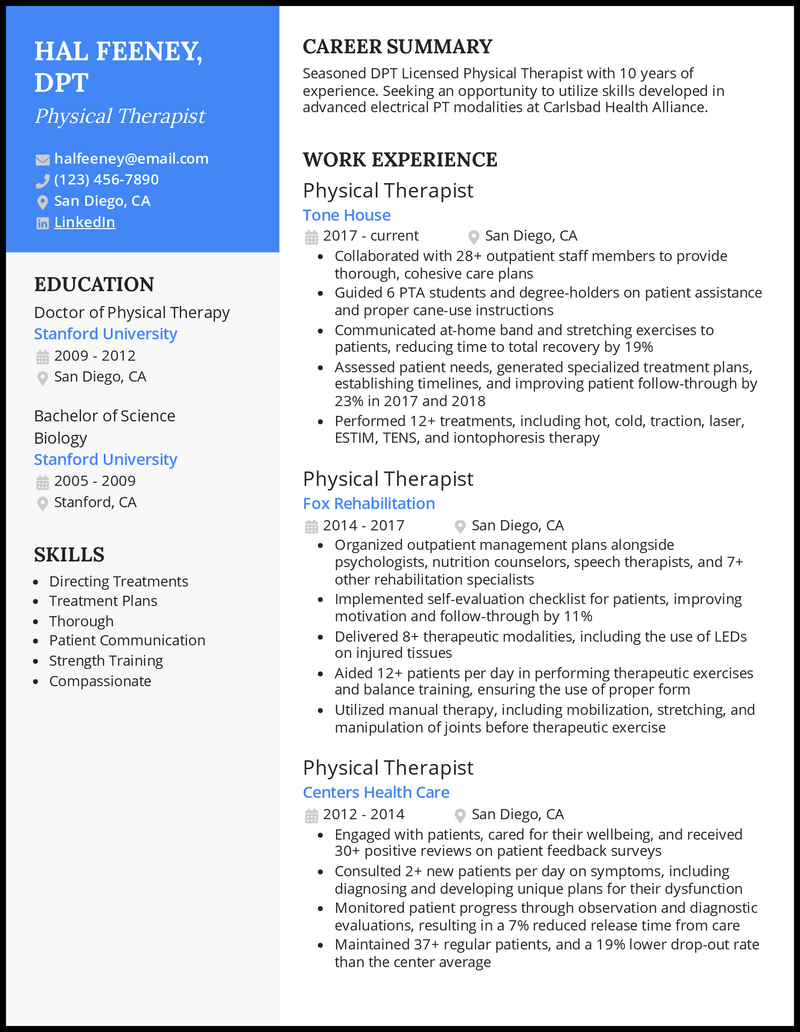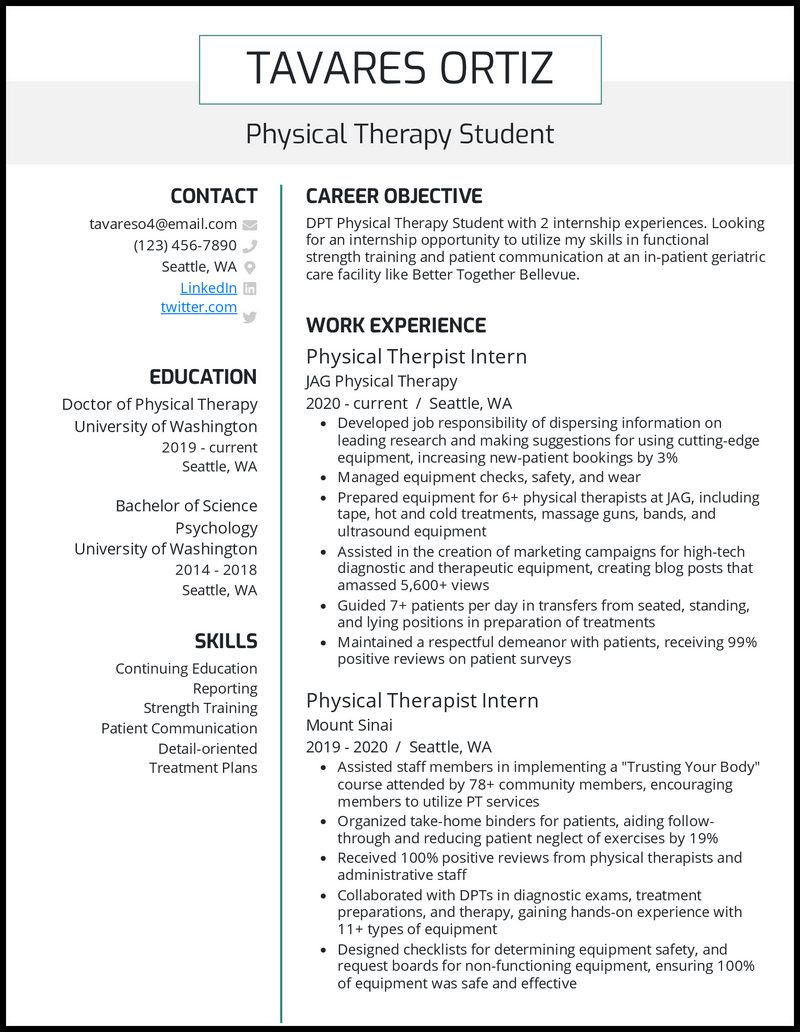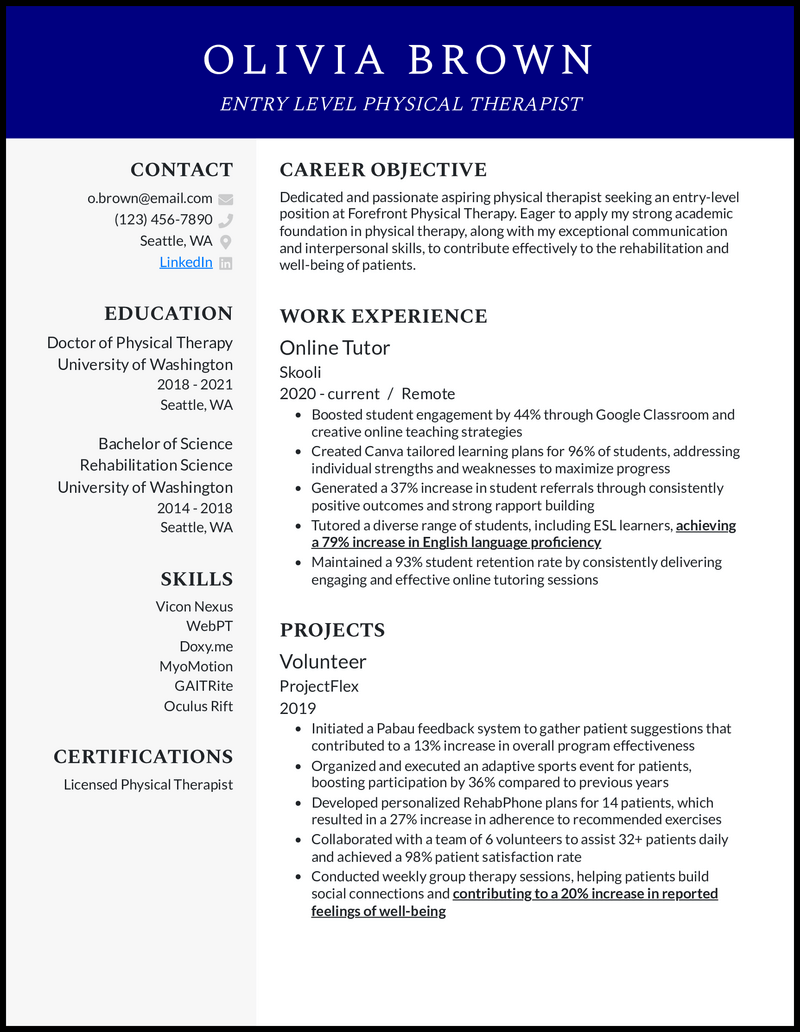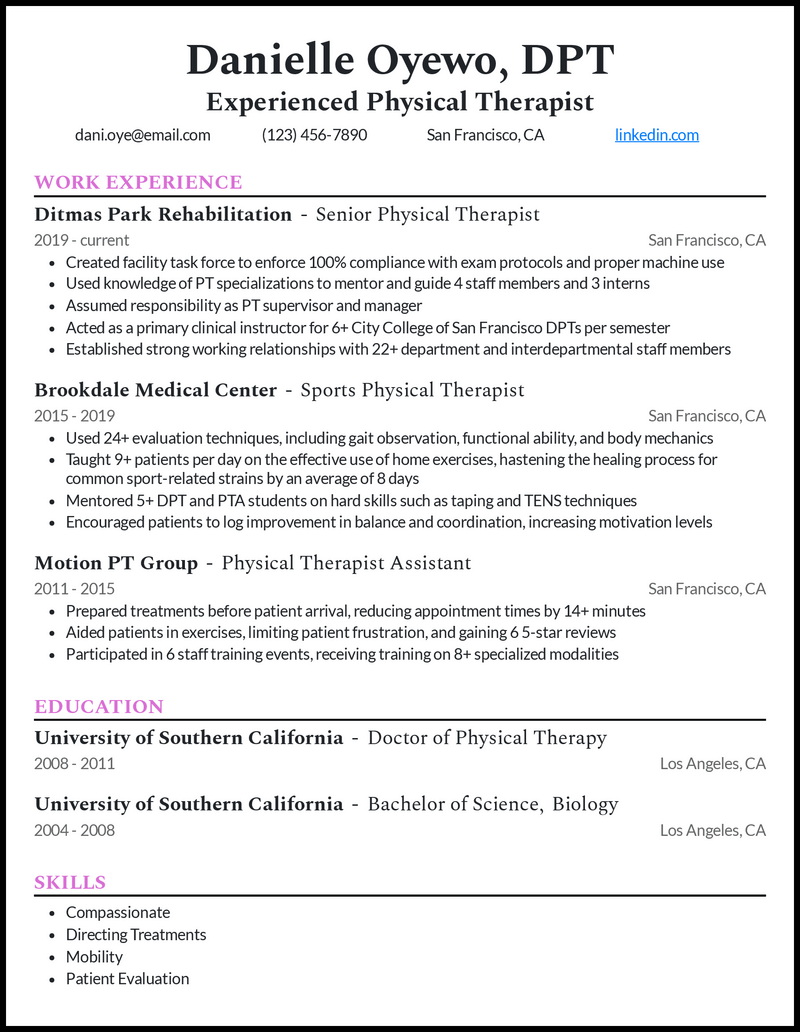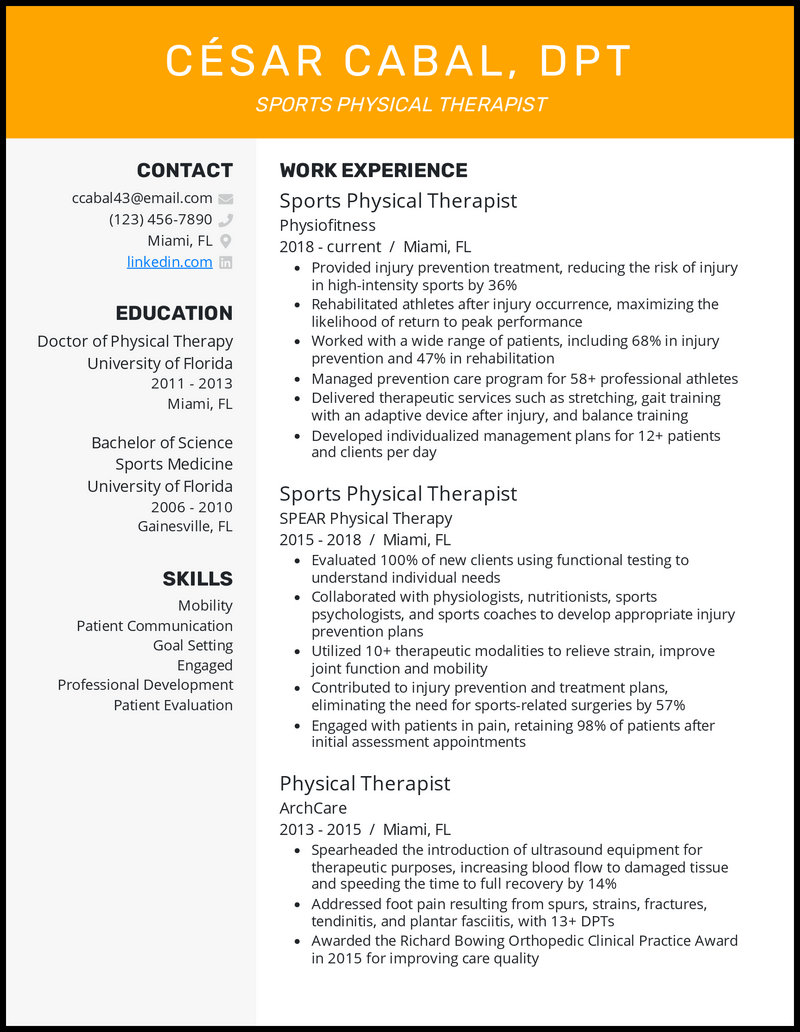You may be ten years into your physical therapy career or working hard toward your advanced degree. Either way, you’re way too busy changing lives to worry about how you should build a resume, not to mention whether you should use a cover letter generator!
We scrutinized hundreds of resumes from physical therapists to tease apart what does and what doesn’t work to help get you interviews in 2025.
With the continued aging of the boomer generation, physical therapist job growth is far exceeding the national average. But the competitive salaries and amazing job prospects generate intense competition. Use these physical therapist resume samples and guide to set yourself apart from the crowd and get more interviews in 2025.
Why this resume works
- If you take away one detail from this resume guide, let it be this—metrics are key.
- As a physical therapist, you can include metrics on patient follow-through, efficient times on your patients per hour, and the number of treatment modalities you provided.
- Proving you can encourage patients to follow through with treatment plans, and reducing the number of sessions they’ll need, is one of the top strengths PT hiring managers seek.
- Not to mention, they spend little time looking at your physical therapist resume— about six seconds! Numbers will catch their eyes and help them absorb your resume’s information more readily.
- Wondering if you should add a resume summary?
- We recommend it if you’ve got 10+ years of field experience under your belt, a specialization or two you’ve honed, and are willing to tailor it to each job you apply for.
Why this resume works
- Achievements from your practical projects can make a difference when you’re looking to break into the real world of jobs. Such projects stand in the gap of the experience you lack by giving hiring managers a chance to assess your abilities.
- Like this physical therapist internship resume, show your impeccable research skills and competencies in data analysis with tools such as Tableau to provide actionable information.
Why this resume works
- Don’t worry if you’re a physical therapist with limited expertise; just consider adding relevant internship, volunteer, or even DPT school projects to your work experience.
- Aim for six bullet points per work experience if you’re lacking job history, but resist filling space with fluff.
- Avoid the fluffy filler temptation by providing meaningful, quantified bullet points instead.
- For example, how many pieces of equipment did you master, how often did you attend training events, and how many types of therapeutic modalities did you learn to use?
- Your physical therapy student resume should fill a whole page, even with just two work experience sections.
- While tricky to achieve, you can kick excess white space to the curb with a resume objective.
- An objective worth it’s salt should: 1. mention the target business by name, 2. list your experience and skills that best match the job description keywords, and 3. read as a two-to-three-sentence snapshot of your best self.
Why this resume works
- Stating the value you’ll bring to a potential employer is one great way to cover for your lack of industry-specific experience.
- However, such a good start will not be enough to help your new grad physical therapist resume impress recruiters. Like this example, highlight your achievements during your voluntary work to help with a rehabilitation program to showcase your potential.
Why this resume works
- Your experienced physical therapist resume can be info-packed without overwhelming the eye. Using quantifiable metrics will save you space and provide a concise demo of your skills.
- You can easily highlight metrics on your number of patient interactions (surveys or reviews) and efficiency in patient healing and appointment lengths.
- Worried about keeping your resume format organized while adding metrics, skills, and all the other details?
- We’ve got just the remedy with ready-to-go resume templates; better yet, you might prefer our Google Docs resume templates or interactive Word resume samples.
- Look for a template that’s professional yet stylish, and don’t be afraid to show some personality with a tasteful splash of color.
Why this resume works
- Ready to position yourself as the pediatric physical therapist every kid (and parent) trusts? Follow the golden rule: be smart with numbers.
- Remember to highlight metrics that actually matter in your predicate physical therapist resume. From improving patient health outcomes and decreasing no-shows to improving motor skills. Even small impacts like helping parents with ever-complicated insurance claims count. These metrics will prove you’re not just great with kids—you’re great at delivering medical recovery results.
Why this resume works
- If you have a lot to say about your outpatient physical therapy prowess, a well-spaced design is going to be your best pal.
- Our range of templates (such as Standout) are ideal for including detailed bullet points that cover your expertise in helping people strengthen weak muscles without cramping your style. With ATS-friendly layouts, you ensure that your outpatient physical therapist resume sails past the bots and lands right in the hands of your next employer.
Why this resume works
- Having limited but job-specific skills at hand following the ability to heal patients does just the right job to showcase your medical expertise. Adding achievements such as lowering reported pain levels and accelerating patient recovery time gives you the space to convince recruiters you’re the ideal candidate for the role.
- Backing this up with powerful metrics and impactful action words is an added perk to perfect your physical therapy aide resume!
Why this resume works
- Let’s assess this physical therapy technician resume: we’ve got a proper structure in place with past experience, a separate section to list skills + education, and highlighted achievements.
- As a hiring manager, scanning through multiple resumes at once, this resume does an exceptional job at grabbing one’s attention towards the USPs first. When drafting your own resume, make sure you’re not presenting cluttered information. Instead, position your resume the right way both concisely and professionally.
Why this resume works
- We recommend listing your work experience in reverse-chronological format on your resume, with your most recent toward the top of the page. But this is even more critical if you’ve been working in physical therapy for several years.
- Employers are reviewing your sports physical therapist resume for just a few seconds, so wow them by highlighting your most recent and most impressive jobs.
- Think about relevancy and include only your most recent three to four work experience sections.
- As a physical therapist, you’ll have completed at least one clinical internship after your advanced degree, but while it’s relevant to add this information on your resume early in your career, it’s unnecessary when you’re years into your professional work history. Just save those extra details for the interview!
Why this resume works
- Remember when professors pleaded for you to read the directions on a test? Well, you should take that advice now, too, and read the employer’s carefully crafted “directions,” (aka the job description).
- One of the best ways to land that interview is to review the company’s job description. They’ve pretty much spilled all the test answers for you.
- We also recommend using the job description to write your resume skills section.
- This section is the second most important on your entire physical therapist assistant resume because it determines if an actual human will ever see your piece before the ATS robot rejects it.
- That’s right. Many employers use applicant tracking systems (ATS) to scan resumes for specific skills from the job description; applicants who leave out the magic keywords do not pass “go” and go straight to the “no” pile.
Related resume guides
Resume Format for a Physical Therapist

It’s time to move on to your physical therapist cover letter, right?
Not so fast! Having a well-formatted resume makes it easier for hiring managers to pay attention to what really matters—your experience in the field. Parse your resume to make sure it’s readable, logical, and complete with a smart structure.

Resume format options
There are three resume formats that are the most popular for 2025
- Reverse-chronological formatting puts your most recent work experience at the top of the page, enabling recruiters to clearly see how you’ve grown in your career.
- Functional formatting puts the emphasis on your skills and is helpful if you have employment gaps.
- Combination/hybrid formatting uses a reverse-chronological format but places equal emphasis on skills and work experience.
Resume Writing for a Physical Therapist

Writing an effective resume is an art that can be tough to learn. We at BeamJobs have spent countless hours mastering the craft, so don’t be hard on yourself! Take it slow, section by section, and you can avoid a lot of frustration. You could think of it like physical therapy, slow and steady progress is the best!
But if you don’t have the time or you find the process tedious, an online resume builder can do the heavy lifting for you.
Now, let’s turn to the meat of your resume. The resume sections
- Resume Objectives and Summaries
- Work Experience
- Skills

What’s the objective/summary all about?
Alright, let us be the first to let you know you don’t necessarily need a resume objective or summary section. But, there are a few times when physical therapists should seriously consider adding one.
Objectives help you communicate your skills and interests in a specific job, whereas resume summaries demonstrate honed specializations and how they’ve quantifiably helped you over the course of your career in physical therapy. Use a resume objective if you’re light on work experience (or going through a substantial career change), and use a summary if you’re a bonafide PT legend with 10+ years of experience.
Examples often make these statements easier to understand, so here are a few poor examples followed by some customized ones:
Poor Objective: highly skilled physical therapist, who’s ready to take the next career step.
Poor Summary: Many years of working experience in PT and PT-related fields.
Why they’re poor: These are vague and nonspecific, and, let’s face it, these both just take up precious room on your resume.
Customize your statement like the objective below instead:

Or dazzle the employer with a brief but tailored summary like this one:


Work experience
Your work experience is important, and we get that every job you’ve held is important to you. But, unless you have limited work experience or you’re under 20, we doubt that the job you held when you were 16 is relevant to your PT resume. Stick with choosing the most related, recent two to four work experiences you have for your resume.

Writing your job description bullet points
If you’re the type of physical therapist who’s constantly obsessing about the grammar on your treatment plan notes, you’ll be thrilled to learn that grammar is critically important on your resume. For the rest of us who would rather forget learning about adverbs in middle school, this topic may fill you with dread.
Rest assured, though, because there are only a few areas where you need to pay special attention
- Use action words like “spearheaded” to start each bullet point.
- Focus on active voice; for example, say “manually manipulated joints,” instead of “the patient’s joints were manually manipulated.”
- Don’t use personal pronouns (like “me,” or “I”).
- Stay consistent with punctuation (you can use periods or not at the end of each bullet point, but be consistent with the one you choose), and use past-tense.
Here are some strong work experience examples:
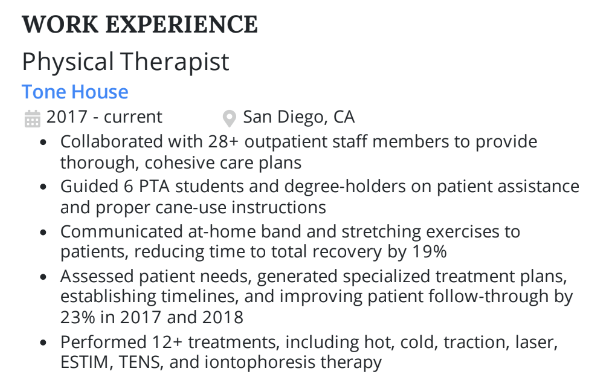
These work because they start with action words, use consistent punctuation (no periods at the end of sentences), avoid personal pronouns, are written in the past tense, and are informative and interesting to read.

Quantify your physical therapist impact
You might want to pull out your old patient records because it’s time to figure out how many sessions you’ve treated patients for (on average) before they graduated from PT. Informative metrics like this are valuable to the hiring team because, while anyone certified can say they’re a great physical therapist, numbers prove you can get the job done when it counts.
Aim for including metrics on 50 percent or more of your bullet points, and if that seems like a difficult number to achieve, focus on leveraging metrics from things like:
- The follow-through of at-home exercises given to patients
- The number of PT modalities you specialize in

Top physical therapist skills to list
The skills section is one of the most important, yet underused of resumes in 2025. But, why is it so important?
First off, the skills section gives you a chance to use keywords that the Applicant Tracking Systems software is looking for. Use six to ten skills with a combination of hard and soft (with extra emphasis on hard skills) to up the chances that your abilities match the desired keywords.
Second, the skills section lets the hiring team know if you’re a good match for that specific job. It’ll help highlight if you’re more skilled in acute sports injury, geriatric injury, or paralysis rehabilitation, for example. Employers will seriously appreciate you making their job easier!
Here are some skills you might want to consider adding to your resume:
- Goal Setting
- Patient Evaluation
- Mobility Training
- Adaptive Equipment Use
- Acute Care
- Mono and Diplegia Rehab Techniques
Why these work: These resume skills are specific to the field, emphasizing hard (like “acute care”) over soft skills (such as “organized”), and they let employers know what your specific skill set really is.

Get hired
Starting the next chapter of your professional career is no joke. We know it can be overwhelming even at the best of times, but you should give yourself a pat on the back! You’ve taken the first step to making your resume the best possible representation of your career and ambitions.
If you’ve been following along this guide with your resume open in another tab, making edits as you read, then go ahead and run your work through our resume checker to get AI-powered tips and a “resume score” that will help you further refine it. Or, if you’ve just realized that your resume needs a total re-do, our resume builder can help you create a properly-formatted resume from the ground up, helping you avoid mistakes and frustration from the start.




